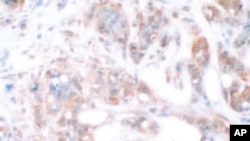What we think of as cancer is not really one disease but a large number of related diseases. And while each is different, they share certain characteristics. These "Hallmarks of Cancer" were identified in an influential publication a decade ago, and now the authors are back with an update.
Writing in the journal Cell in 2000, Doughas Hanahan and Robert A. Weinberg identified six cellular traits as "Hallmarks of Cancer." They included features such as sustained growth of blood vessels to feed the growing cancer and what the authors called "self-sufficiency in growth signals."
"Normal cells in our tissues will not start growing unless they're stimulated to do so by getting signals from their neighbors," Weinberg explained in a telephone interview.
"However, cancer cells become independent of these signals from their neighbors, and as a consequence they stimulate their own growth, making them independent and allowing them to drive their own proliferation relentlessly."
Weinberg, who is affiliated with the Massachusetts Institute of Technology and the Whitehead Institute for Biomedical Research, both in Cambridge, Massachusetts, says the value of identifying these hallmarks of cancer is that they can suggest new ways of fighting cancer that might be more effective than current therapies.
"In other words, there may be two or three molecules inside cancer cells that are functioning abnormally in order to confer on the cancer cell unrelenting growth. And if we hit this hallmark vulnerability, then we believe we may be able to get a long-term clinical response," he said.
In the decade since the original Hallmarks article was published, there has been a lot of cancer research. The newly-published version of the Hallmarks paper reflects a better understanding of the original six hallmarks, plus two new ones.
"One of them is the need for a tumor, during its development, to evade elimination by the immune system. Another is the possibility that tumor cells have a very unusual metabolism, which sets them apart from normal cells," Weinberg said.
And that might suggest another vulnerability that could be targeted by cancer researchers.
The original "Hallmarks of Cancer" article has been cited by other researchers more often than any other paper published by the journal Cell, which also published the update. Despite that benchmark for influence in the scientific community, Robert Weinberg admits that his analysis of cancer's hallmarks has not yet had a major impact in actually producing new cancer treatments.
Shared Traits Could Help Scientists Find Cancer Cure
- By Art Chimes

But 'Hallmarks of Cancer' haven't yet fulfilled promise







